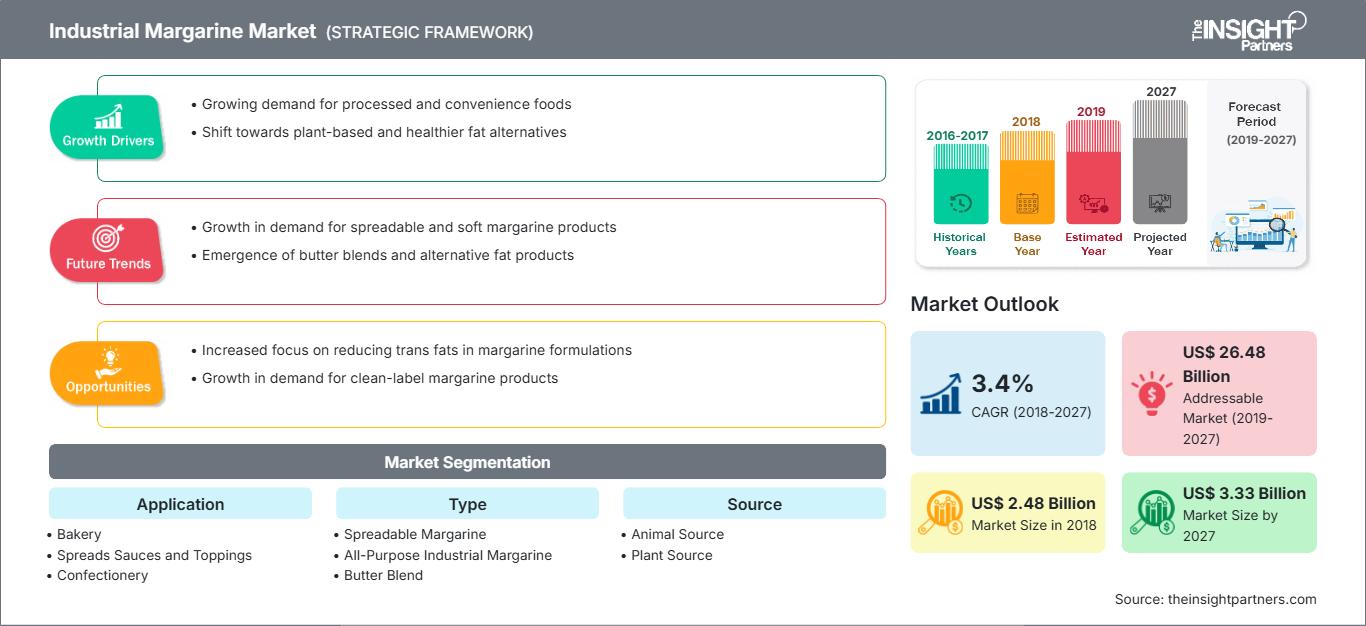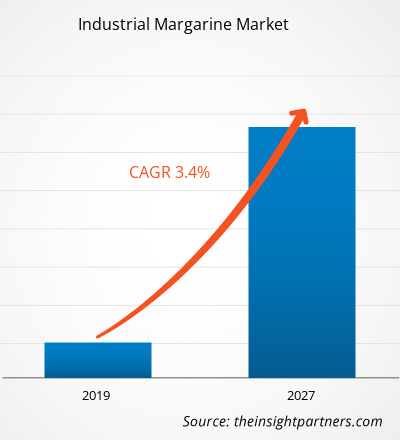[Informe de investigación] El mercado de margarina industrial se valoró en US$ 2.480,0 millones en 2018 y se proyecta que alcance los US$ 3.330,4 millones para 2027; se espera que crezca a una CAGR de 3,4% de 2019 a 2027.
La margarina industrial es un producto lácteo que se utiliza como sustituto de la mantequilla. Si bien tanto la margarina industrial como la mantequilla se utilizan para realzar el sabor de diversos platos, tienen características distintivas. La mantequilla está compuesta de agua, proteínas y grasa butírica, mientras que la margarina industrial está compuesta de grasa animal o aceite vegetal procesado.
Se espera que el mercado de margarina industrial en Norteamérica alcance su mayor CAGR durante el período de pronóstico. Este crecimiento se atribuye principalmente a la creciente prevalencia de enfermedades como la diabetes, la hipertensión y el estreñimiento, a medida que los consumidores se preocupan más por su salud. Por ello, los productores de alimentos en Estados Unidos se están centrando en la fabricación de margarinas sin grasas trans. La creciente demanda de margarina industrial se ve impulsada por el número de nuevos lanzamientos de margarinas modificadas por parte de los fabricantes, como las margarinas bajas en grasa o sin grasa y la margarina fortificada con leche enriquecida con vitamina D. La creciente demanda de margarina industrial en Norteamérica ha atraído a los fabricantes a establecer su presencia en la región, lo que ha impulsado aún más el crecimiento del mercado de margarina industrial en Europa.
Obtendrá personalización en cualquier informe, sin cargo, incluidas partes de este informe o análisis a nivel de país, paquete de datos de Excel, así como también grandes ofertas y descuentos para empresas emergentes y universidades.
Mercado de margarina industrial: Perspectivas estratégicas

-
Obtenga las principales tendencias clave del mercado de este informe.Esta muestra GRATUITA incluirá análisis de datos, desde tendencias del mercado hasta estimaciones y pronósticos.
Impacto de la pandemia de COVID-19 en el mercado de margarina industrial
El brote de COVID-19 ha afectado negativamente a las economías e industrias de varios países debido a confinamientos, prohibiciones de viaje y cierres de negocios. La industria de alimentos y bebidas se encuentra entre las industrias más importantes que sufren graves interrupciones, como restricciones en la cadena de suministro y el cierre de plantas de producción. Los efectos globales de la enfermedad por coronavirus 2019 (COVID-19) ya se están sintiendo, y la demanda de margarina en bloque en 2020 se verá significativamente afectada. La COVID-19 ha influido en el comportamiento y la demanda de los consumidores, los hábitos de compra, la reorientación de la cadena de suministro, la dinámica del mercado y la intervención gubernamental. Por lo tanto, estos factores están frenando el crecimiento del mercado de margarina industrial en la industria de alimentos y bebidas.
Perspectivas del mercado
Se espera que la creciente demanda de alimentos bajos en calorías impulse el crecimiento del mercado de margarina industrial.
El mercado de la margarina industrial está en crecimiento debido a la creciente demanda de alimentos y bebidas bajos en grasa, resultado de la evolución de los estilos de vida y una mayor concienciación sobre la salud. Los jóvenes son cada vez más conscientes de los beneficios para la salud de una dieta equilibrada, como la prevención de la obesidad y la diabetes. El crecimiento del mercado debería verse impulsado por un aumento en la oferta de alimentos bajos en calorías en los supermercados, así como por los importantes esfuerzos de investigación y desarrollo que realizan los fabricantes para ampliar su gama de productos y vender productos de mejor calidad a precios bajos. Vandemoortele, Unilever Plc, Richardson International Limited y Conagra Brands, Inc. se encuentran entre los principales fabricantes de margarina industrial que comercializan margarina industrial baja en calorías para atraer a la generación más joven preocupada por su salud.
Información sobre tipos
Según el tipo, el mercado de la margarina industrial se divide en margarina untable, margarina industrial multiusos y mezcla de mantequilla. El segmento de la margarina industrial untable representó una mayor participación de mercado en 2018. En comparación con la mantequilla, la margarina industrial se unta mejor a temperatura ambiente. Debido a su superior untabilidad, la margarina se ha convertido en un untable de mesa más popular y económico. La margarina industrial sigue siendo un untable común para tostadas y pan. Se usa comúnmente como sustituto de la mantequilla, más costosa, debido a su suavidad y textura cremosa. Las margarinas para untar suelen ser bajas en colesterol y grasas trans, lo que las convierte en una alternativa equilibrada. Es probable que el bajo colesterol LDL de la margarina industrial impulse el mercado, ya que es cada vez más consumida por consumidores preocupados por el colesterol.
De esta forma, se espera que todos estos factores impulsen la demanda de margarina industrial durante el período de pronóstico.
Perspectivas de la aplicación
Según la aplicación, el mercado de la margarina industrial se segmenta en panadería, untables, salsas y coberturas, confitería, comida preparada y otros. El segmento de panadería representó la mayor participación de mercado en 2018. La margarina para croissants, la margarina de hojaldre duro, la margarina de crema de mantequilla, la margarina para pasteles y la margarina de hojaldre son los tipos más populares de margarina industrial utilizados en la industria de la panificación. La margarina se utiliza para producir masa de trigo tierna en una variedad de productos horneados. Los panaderos prefieren la margarina debido a su textura suave, lo que facilita batir glaseado de crema de mantequilla o azúcar crema para un bizcocho. Los pasteles daneses se hacen con margarina que se enrolla. La margarina en barra, también conocida como margarina en bloque o margarina áspera, tiene una textura similar a la mantequilla y, por lo tanto, se utiliza como un sustituto de la mantequilla en la repostería y la cocina. Durante el período de pronóstico, se espera que el aumento del consumo conjunto de margarina industrial en la panadería impulse la demanda del producto.
Entre los actores que operan en el mercado de la margarina industrial se encuentran Associated British Foods, Bunge Limited, Conagra Foodservice, Inc., EFKO Group, Fuji Oil Europe, NMGK Group, Puratos, Richardson International Limited, Vandemoortele y Wilmar International Limited, entre muchos otros. Las empresas clave implementan fusiones y adquisiciones, así como estrategias de investigación y desarrollo, para ampliar su cartera de clientes y obtener una participación significativa en el mercado global, lo que también les permite mantener su marca a nivel mundial.
Perspectivas regionales del mercado de margarina industrial
Los analistas de The Insight Partners han explicado detalladamente las tendencias regionales y los factores que influyen en el mercado de la margarina industrial durante el período de pronóstico. Esta sección también analiza los segmentos y la geografía del mercado de la margarina industrial en América del Norte, Europa, Asia Pacífico, Oriente Medio y África, y América del Sur y Central.
Alcance del informe de mercado de margarina industrial
| Atributo del informe | Detalles |
|---|---|
| Tamaño del mercado en 2018 | US$ 2.48 mil millones |
| Tamaño del mercado en 2027 | US$ 3.33 mil millones |
| CAGR global (2018-2027) | 3,4% |
| Datos históricos | 2016-2017 |
| Período de pronóstico | 2019-2027 |
| Segmentos cubiertos |
Por aplicación
|
| Regiones y países cubiertos |
América del norte
|
| Líderes del mercado y perfiles de empresas clave |
|
Densidad de actores del mercado de margarina industrial: comprensión de su impacto en la dinámica empresarial
El mercado de la margarina industrial está creciendo rápidamente, impulsado por la creciente demanda del consumidor final debido a factores como la evolución de las preferencias del consumidor, los avances tecnológicos y un mayor conocimiento de los beneficios del producto. A medida que aumenta la demanda, las empresas amplían su oferta, innovan para satisfacer las necesidades del consumidor y aprovechan las tendencias emergentes, lo que impulsa aún más el crecimiento del mercado.

- Obtenga una descripción general de los principales actores clave del mercado de margarina industrial
Informe destacado
- Tendencias progresivas de la industria en el mercado de margarina industrial para ayudar a los actores a desarrollar estrategias efectivas a largo plazo.
- Estrategias de crecimiento empresarial adoptadas por los mercados desarrollados y en desarrollo
- Análisis cuantitativo del mercado de margarinas industriales de 2019 a 2027
- Estimación de la demanda mundial de margarina industrial
- Análisis PEST para ilustrar la eficacia de los compradores y proveedores que operan en la industria
- Desarrollos recientes para comprender el escenario del mercado competitivo
- Tendencias y perspectivas del mercado, así como factores que impulsan y restringen el crecimiento del mercado de margarina industrial.
- Asistencia en el proceso de toma de decisiones destacando las estrategias de mercado que sustentan el interés comercial, lo que conduce al crecimiento del mercado.
- El tamaño del mercado de margarina industrial en varios nodos
- Descripción detallada y segmentación del mercado, así como la dinámica de la industria de la margarina industrial.
- Tamaño del mercado de margarina industrial en diversas regiones con prometedoras oportunidades de crecimiento
Mercado de margarina industrial por aplicación
- Panadería
- Untables, salsas y aderezos
- Confitería
- Comida de conveniencia
- Otros
Mercado de margarina industrial por tipo
- Margarina untable
- Margarina industrial multiusos
- Mezcla de mantequilla
Mercado de margarina industrial – por origen
- Origen animal
- Fuente vegetal
Mercado de margarina industrial – por formato
- Margarina industrial dura
- Margarina industrial blanda
Perfiles de empresas
- Bunge Limited
- Alimentos británicos asociados plc.
- Marcas Conagra, Inc.
- Grupo EFKO
- Fuji Oil Europa
- Grupo NMGK
- Puratos
- Richardson International Limited
- Vandemoortele
- Wilmar Internacional Ltd.
- Análisis histórico (2 años), año base, pronóstico (7 años) con CAGR
- Análisis PEST y FODA
- Tamaño del mercado, valor/volumen: global, regional y nacional
- Industria y panorama competitivo
- Conjunto de datos de Excel
Informes recientes
Testimonios
Razón para comprar
- Toma de decisiones informada
- Comprensión de la dinámica del mercado
- Análisis competitivo
- Información sobre clientes
- Pronósticos del mercado
- Mitigación de riesgos
- Planificación estratégica
- Justificación de la inversión
- Identificación de mercados emergentes
- Mejora de las estrategias de marketing
- Impulso de la eficiencia operativa
- Alineación con las tendencias regulatorias






















 Obtenga una muestra gratuita para - Mercado de margarina industrial
Obtenga una muestra gratuita para - Mercado de margarina industrial